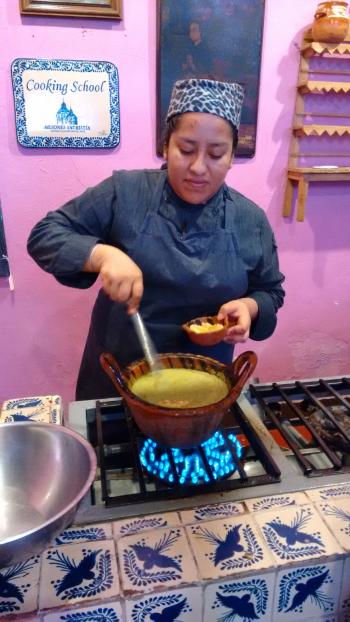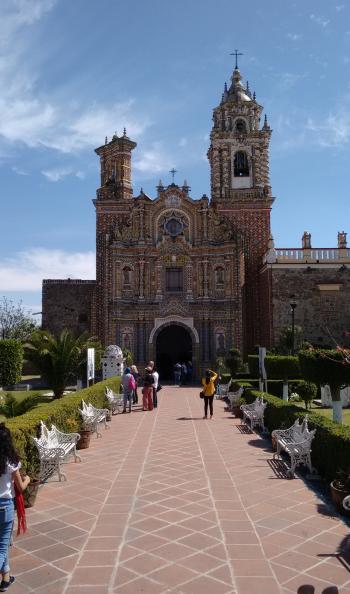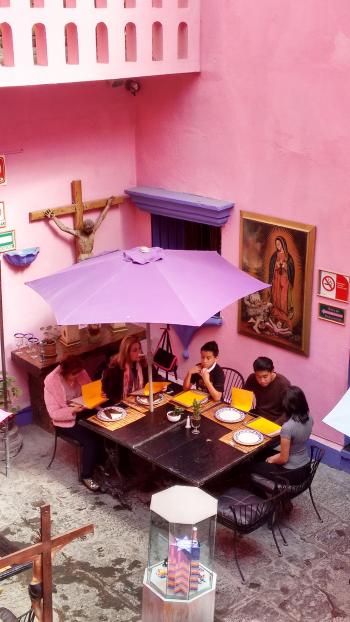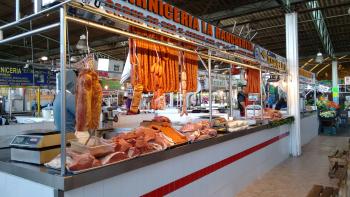A week of cooking and culture in Puebla, Mexico — an incredible experience at a rock-bottom price
This article appears on page 20 of the June 2018 issue.
Chef Ruth Ruiz announced, “This morning we’re going to the market to buy a pig’s head.”
It was the last day of our Mexican cooking school adventure, and we’d be making a special soup often served at celebrations: pozole con puerco.
My wife, Joy, and I had signed on for an attractively priced, 7-day, 6-night package that included our room, meals and cooking classes at Mesón Sacristía de la Compañía hotel and restaurant in Puebla, Mexico (Feb. 3-9, 2018). Since the trip was all about food, I’ll get right to it.
Jumping in
Personable Ruth Ruiz, the head chef of the restaurant and its cooking school, has impressive credentials. Among other things, she was the official (and only) delegate from Mexico to attend a recent chefs’ conference in Montréal. Her restaurant menu is extensive and quite traditional, with no fancying up for show, just the best and freshest ingredients carefully prepared to create very flavorful dishes. Ruth’s mole poblano (a rich, dark and multiflavored sauce) is legendary, and guidebooks routinely direct connoisseurs to Mesón Sacristía for the real thing.
We found it a joy to be her students. We had Ruth to ourselves as the only students for the week, so our experience went far beyond just watching her cook. She had us doing a bit of everything, from peeling garlic (me) to washing that pig’s head (Joy) to sautéing, deep frying, roasting, scorching, blending and chopping.
Ruth’s cooking techniques held some surprises. They were perhaps more restaurant-style than home cooking; we used a professional-grade blender for almost everything we prepared, dropping in whole tomatoes, onions, carrots, chilies and pumpkin seeds; pineapple quarters; garlic cloves; cinnamon bark and much more for a thorough whacking until smoothly pureed.
We reduced tortillas to char over a gas flame for a smoky flavor. Meats were almost always cooked in water or a pressure cooker. Even creamy desserts got the brute-force blender treatment, with great success.
We poured icy-cold liquids into traditional clay bowls that had been preheated over a gas flame to a high sizzle.
“Don’t they ever crack?” I asked. “Never,” Ruth responded. Her favorite at home was handed down by her grandmother.
Mole and more
Our first day focused on moles, and, as we learned, there are very many varieties, of which we made just four. Mole poblano, Puebla’s unique contribution to Mexican cuisine, was the standout, of course.
This very complex sauce is a collection of two dozen or more ingredients, including a variety of spices and herbs, and the resulting range of flavors was a surprise.
Ruth’s recipe includes a mind-blowing combination of such things as scorched vegetables, animal crackers, nuts, raisins, plantains, incinerated tortillas, a variety of dried chilies, chicken stock, lots of toasted sesame seeds and a good-size block of chocolate. All that is blended into a smooth sauce, then cooked down to merge the flavors.
Allowed to rest for at least a day for flavor maturity, the result is a thick sauce that is somewhat sweet but balanced with hot spices. That balance, Ruth says, is the key to an excellent mole.
Lunch was poached chicken in mole poblano served with rice and beans, leaving no room for dessert but just enough to enjoy the complimentary homemade liqueur that topped off the meal. Beer, wine and a big pitcher of agua fresca (water enhanced with pureed fruit and spices) were also included.
Days two and three featured sauces and salsas, Mexican-menu staples. Like mole, they involved many ingredients. Sauces were pureed, then simmered to smooth perfection; the salsas were blended cold.
Again, there are many varieties, and we prepared three or four in each category, going through lots of tomatoes, tomatillos, onions, peppers, pineapple, bales of parsley and cilantro and many other ingredients.
Baked tortilla chips were on hand to dip into the sauces, and we assembled a stack of chalupas (small, stuffed fried tortillas) to show off the salsas. All that tasting meant that the lunch to follow was necessarily on the light side.
Puddings and pozole
Our fourth day was devoted to postres (desserts). Mexican cuisine favors custards, puddings and cakes, and we produced creamy rice pudding, flan de queso (cream cheese custard) and two other puddings — eight servings in all, and all for us!
For lunch that day, we had a round of margaritas followed by enchiladas in pipián verde (green pumpkin seed-chili sauce) and then those eight desserts. We sized up the sweets as being enough for at least a few meals, so we asked the kitchen to put some away for after dinner.
Day five had us making the pig’s head pozole (hominy-based soup). We took an Uber to the huge central market and followed Ruth to the meat section. Sure enough, there were a few vendors displaying pigs’ heads. Ruth decided a half-head was enough, so one was band-sawn down the middle and sectioned.
Back in the kitchen, Joy got the task of washing the pig parts, which went right into a big pressure cooker along with onions and herbs. A hunk of pork shoulder was added to populate the soup with some tender meat.
The rest was hominy, vegetables, more herbs and spices and the mandatory assortment of peppers. The soup served as our lunch, accompanied by huauzontles (fritters made from cheese and a native edible plant served in a spicy tomato sauce).
Ruth teaches in a small demonstration kitchen, perfect for two and probably fine for up to six students. She accommodates up to 12 people, usually an organized group, and that’s a crowd that would, by necessity, do more watching than doing. There is an overhead mirror to help in seeing Ruth’s demonstration.
It was our impression that a crowd is rare there. During our week in February, just one other student (an American man) came in for a short afternoon class. Classes are available by the hour or in various multiday packages and do not require a stay at the hotel.
We’d rate our cooking experience a 10 out of 10.
The restaurant
The restaurant was also wonderful, and we enjoyed a good sampling of its wide-ranging dinner menu, everything from a shared, meal-size nachos appetizer — unique and the best we’ve ever had — to the 5-mole sampler plate. Breakfasts offered a smaller menu, including fresh-squeezed juices, a fruit plate, Mexican-style eggs and even excellent pancakes (a bow to North American visitors).
That our package included ordering anything we wanted for dinner — and as much as we wanted — was an unexpected bonus and a test of our resolve. Although we paid nothing beyond our package price, I did look at the right side of the menu, where I found reasonable, mid-range prices; few main courses exceeded $11 (all prices were in US dollars).
Both the red and white private-label Sacristía wines were quite satisfactory, and the bar dispensed a fine margarita. Bottled water is the rule in the restaurant, kitchen and classes, including for ice, so not to worry.
The waiters were all pros and delivered caring, attentive service. Enough English was spoken by staff to allow us to manage easily (Ruth is fluent), and an English menu was available.
The ambiance was pleasant, with lots of greenery, soft music and a low noise level. Open hours seemed a bit erratic, so it’s best to check before visiting (phone 222 242 45 13).
We’d recommend Sacristía’s restaurant to anyone visiting Puebla, whether hotel guest, student or neither. We give it an unconditional 10 out of 10.
Accommodations
The 9-room boutique hotel is a thoroughly remodeled but still quaint 250-year-old residential complex with seven junior suites and two full suites, all located on the second floor around an open courtyard and furnished throughout with antiques reflecting the owner’s vocation. Our room (No. 5) was a junior suite that included a huge desk, another small desk, an armoire “closet” and an overstuffed sofa, all separated from the king-bed sleeping area by a brick archway. The bathroom was small but more than adequate. Its 300-year-old timber door was from a historic jail.
Some rooms have balconies overlooking the quiet Callejón de los Sapos (Alley of the Toads). Ours had a window that looked out onto the courtyard.
Housekeeping was very good, and the 24-hour reception desk staff was helpful beyond our expectations. The location is very good on what is essentially a walking street, just two blocks from the beautiful zócalo (central square) and within a short walk of many of Puebla’s best attractions.
Rooms run about $75, double, with breakfast, and there is free valet parking. We recommend this hotel highly for its character, comfort, service, location and value, and we give it a 9.5/10 rating, with the only caveats being no elevator to the second-floor rooms and what some have called “kitsch” décor — not everyone’s preference but just like home for us.
The details
Mesón Sacristía de la Compañía (6 sur 304 Callejón de los Sapos; mesones-sacristia.com) showed up by chance in our Internet search for a different school in Puebla marketed by Epitourean (800/390-3292, epitourean.com), the agency that booked our culinary week in Italy two years ago. (For information on that excellent Italian experience, see ITN Feb. ’18, page 28, or, online, see Epitourean’s offering in Castro dei Volsci or visit italyculinaryholiday.com).
We also found Sacristía in Saveur magazine as offering one of five recommended cooking-class packages in Mexico. It was the only one listed with more than just hourly lessons. (See saveur.com/article/Travels/5-Mexican-Cooking-Schools.)
We liked the sound and look of Sacristía and its location in the heart of Puebla’s preserved historic district. The hotel was highly recommended, and the restaurant was “not to be missed” according to popular guidebooks.
Students also praised the cooking classes on TripAdvisor.com.
We found convenient American Airlines flights to Puebla from Minneapolis, with a stop in Dallas/Fort Worth.
The hotel package included a total of 15 morning hours, more or less, of hands-on instruction, six nights’ accommodation, daily breakfast and dinner and our culinary handiwork for lunch supplemented by menu items for a full meal, with drinks on the house.
There was also a “highlights” bus tour of the city and a visit to the spectacular new, world-class International Museum of Baroque — well worth an afternoon’s attention.
At $750 each (without airfare), the all-inclusive price was way less than Epitourean’s typical offerings (even when allowing for their frequent discounts of 50% or more) — a genuine bargain!
Hotel transfers to and from the distant Puebla airport were offered for $30 per trip, and Uber and licensed taxis were readily available as well (about $16). Mexico City’s airport is a 2- to 3-hour ride by bus (about $30 round trip), or you can take a hotel transfer ($120 each way per group).
Our package included two free afternoons that we used to visit the nearby crafts market and the excellent art and culture collections at Museo Amparo and the Puebla Cultural Center, each an easy stroll from our hotel. The open-air railway museum was reached by Uber.
We also took a 4-hour bus tour ($18 each) to suburban Cholula to see its historic churches and Mexico’s largest Aztec pyramid, now just a big hill with a spectacular church built on top. The pyramid can best be appreciated by visiting the adjacent museum.
I’ll be pleased to offer tips and suggestions via email (carlsons@q.com).




